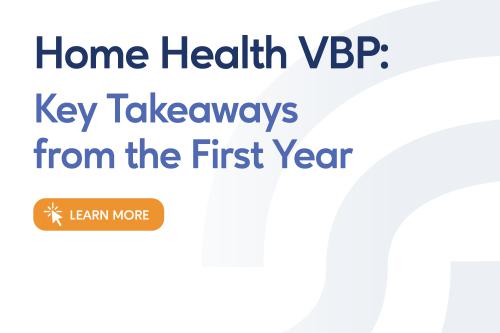Home Health VBP: Lessons Learned from Year One

Home health agencies (HHAs) across the nation are in the midst of a major transformation driven by Home Health Value-Based Purchasing (HHVBP). This program ties reimbursement to the quality of care provided, incentivizing HHAs to improve patient outcomes. This blog post dives into the key takeaways from the first performance year of HHVBP (2023) to help HHAs optimize their performance in the coming years.
Understanding Home Health VBP
HHVBP aims to move home health care away from a fee-for-service model and towards rewarding quality and better patient outcomes. Here’s a quick rundown:
- Nationally Implemented: HHVBP launched for all Medicare-certified HHAs across the US in 2023.
- Performance Years & Payment Impact: 2023 was the first performance year (PY), with results impacting payment by up to plus or minus 5% in 2025.
- Competition and Scoring: Agencies compete within their size cohort (large or small) based on a Total Performance Score (TPS). This score is derived from performance measures calculated from claims, OASIS assessments, and HHCAHPS surveys.
Optimizing Performance for Higher Reimbursement
Maximizing reimbursement under HHVBP requires strategic planning and data-driven decision-making. Here are some key insights gleaned from the first year of the program:
- Utilize Available Resources: Many agencies aren’t fully utilizing resources like the Interim Performance Report (IPR) from CMS via iQIES. This report offers valuable data on your agency’s performance compared to your cohort. Don’t leave this treasure trove of information untapped! Instructions on how to access the IPRs are available on the Expanded HHVBP Model webpage, under “Model Reports.”
- Achievement & Improvement: Points are earned both by outperforming relative to the national baseline median (“achievement points”) and by improving over your individual agency’s baseline score (“improvement points”), with the higher of the earned points for each measure contributing to your TPS.
- Track Your Progress: After implementing changes, regularly monitor your performance. This allows you to adapt your strategies based on the results and identify areas that require further attention. Don’t just make changes and hope for the best; track the impact of your efforts to ensure you’re moving in the right direction to succeed in HHVBP.
Prioritizing Improvement Efforts:
- Analyze the Impact on TPS: Identify the measures with your cohort’s lowest scores and percentile rankings. Don’t spread yourself too thin; target the areas with the biggest opportunity under HHVBP.
- Consider Weighting: Some measures contribute more to the TPS than others. Strategize your improvement efforts by prioritizing measures with a higher weight in the HHVBP scoring system. Not all measures are created equal; concentrate on the ones that count the most.
- Think Holistically: Focus on efforts that can positively impact multiple metrics. For example, reducing hospital admissions might also increase your discharge to community score. A holistic approach can maximize your return on investment under HHVBP.
Key VBP Performance Drivers:
- Preventing Hospitalizations: More than one-quarter of your TPS will come from the hospitalization measure—it’s the metric with the greatest impact on your VBP positioning. Helping patients stay healthy at home is a win-win for both patients and the agency.
- HHCAHPS Scores: The patient experience measured through HHCAHPS surveys significantly impacts the TPS. Encourage patient participation and strive for positive feedback in all categories. Learn how to provide a consistent patient experience and improve your HHCAHPS results HHCAHPS survey.
- OASIS Accuracy: Accurate completion of OASIS assessments directly affects multiple performance measures. To ensure accurate data collection, utilize a combination of observation, interviews, and collaboration among staff. Clean data is essential for good performance under HHVBP.
Lessons Learned from VBP Year One and Recommendations:
The first year of HHVBP has provided valuable insights for HHAs nationwide. By leveraging data analytics, focusing on improvement, and prioritizing patient-centered care, agencies can successfully navigate the HHVBP landscape and secure higher reimbursement while delivering exceptional home health services.
- Scores are Increasing: TPS values have been steadily increasing, which means that it will be harder for individual agencies to be on the “plus” side of the reimbursement impact equation. Don’t rely on past performance for future success; continuous improvement is essential under HHVBP.
- Consider Drilling Down: If your agency is large enough, drilling down to analyze performance by team, location, or service line can help you identify high- and low-performance areas, pinpoint where improvement efforts will have the most impact, and learn from successes.
- Focus on Patient Feedback: HHCAHPS scores and comments offer valuable insights beyond just the top-box ratings used for public reporting. Analyze responses across the spectrum (“Never/ Sometimes” and “Usually”) and qualitative comments to understand where patients have concerns and close the gap between current and target scores.
Conclusion: Learning From the First Year of HHVBP
The first year of Home Health VBP has presented both challenges and opportunities for HHAs. Agencies can excel under this new program by implementing a data-driven approach, focusing on continuous improvement, and prioritizing patient-centered care. Remember, HHVBP is ultimately about delivering the highest quality of care to patients in the comfort of their own homes. By prioritizing patient well-being, HHAs can achieve financial success and make a significant positive impact on their patients’ lives.
Additional Resources:
- Centers for Medicare & Medicaid Services (CMS): https://www.cms.gov/priorities/innovation/innovation-models/home-health-value-based-purchasing-model
- Home Health Compare: https://medicare.gov/care-compare/index.html
We hope this blog post empowers HHAs to navigate the Home Health VBP landscape and thrive in the years to come. Learn more about how SimiTree can help you with the following VBP services on our website, or request a consultation today using the contact form below.
- VBP Assessment
- VBP Data Analytics
- Personalized Work Plan and Implementation Assistance
- Individualized Performance Improvement Projects
- QAPI Program Oversight
- Customized Staff Training Programs

